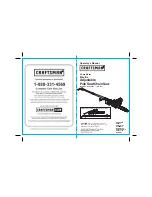
25
24
OPERATION cont.
OPERATION cont.
INSTRUCTIONS CONCERNING THE PROPER TECHNIQUES FOR BASIC
FELLING, LIMBING, AND CROSS-CUTTING (see Figures A, B, C, D, E and F) cont.
INSTRUCTIONS CONCERNING THE PROPER TECHNIQUES FOR BASIC
FELLING, LIMBING, AND CROSS-CUTTING (see Figures A, B, C, D, E and F) cont.
3. Felling back cut cont.
As the felling gets close to the
hinge, the tree should begin to fall.
If there is any chance that the tree
may not fall in desired direction or
it may rock back and bind the saw
chain, stop cutting before the felling
back cut is complete and use wedges
of wood, plastic or aluminium to
open the cut and drop the tree along
the desired line of fall.
When the tree begins to fall remove the chain saw from the cut, stop the motor, put the chain
saw down, then use the retreat path planned.
Be alert for overhead limbs falling and watch your footing.
Fig. A.
4. Limbing a tree
Limbing is removing the branches
from a fallen tree. When limbing leave
larger lower limbs to support the log
off the ground. Remove the small
limbs in one cut as illustrated in
Fig. B. Branches under tension
should be cut from the bottom up
to avoid binding the chain saw.
Fig. B.
5. Bucking a log
Bucking is cutting a log into lengths. It is important to make
sure your footing is firm and your weight is evenly distributed
on both feet. When possible, the log should be raised and
supported by the use of limbs, logs or chocks.
Follow the simple directions for easy cutting.
When the log is supported along its entire length
as illustrated in
Fig. C., it is cut from the top (overbuck).
Fig. C.
Bucking a log cont.
When the log is supported on one end,
as illustrated in
Fig. D., cut 1/3 the diameter from
the underside (underbuck).
Then make the finished cut by overbucking
to meet the first cut.
When the log is supported on both ends,
as illustrated in
Fig. E, cut 1/3 the diameter from the
top (overbuck).
Then make the finished cut by underbucking
the lower 2/3 to meet the first cut.
Fig. D.
Fig. E.
When bucking on a slope always stand on the
uphill side of the log, as illustrated in
Fig. F.
When “cutting through”, to maintain complete
control release the cutting pressure near the end
of the cut without relaxing your grip on the chain
saw handles. Don’t let the chain contact the ground.
After completing the cut, wait for the saw chain to
stop before you move the chain saw.
Always stop the motor before moving from tree
to tree.
Fig. F.
CUTTING WITH CHAINSAW cont.
CUTTING WITH CHAINSAW cont.

























